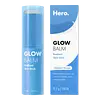What's inside
What's inside
 Key Ingredients
Key Ingredients

 Benefits
Benefits

 Concerns
Concerns

 Ingredients Side-by-side
Ingredients Side-by-side

Propylene Glycol
HumectantWater
Skin ConditioningSodium Stearate
CleansingCeteareth-25
CleansingGlycerin
HumectantPropanediol
SolventTotarol
AntioxidantSodium Hyaluronate
HumectantTocopheryl Acetate
AntioxidantChlorella Vulgaris Extract
Skin ConditioningAvena Sativa Kernel Flour
AbrasiveMelia Azadirachta Leaf Extract
Skin ConditioningCorallina Officinalis Extract
Skin ConditioningCoccinia Indica Fruit Extract
Skin ConditioningMelia Azadirachta Flower Extract
Skin ConditioningSolanum Melongena Fruit Extract
Skin ConditioningAloe Barbadensis Flower Extract
EmollientSambucus Nigra Fruit Extract
AstringentCalendula Officinalis Flower Extract
MaskingOcimum Sanctum Leaf Extract
Skin ConditioningOcimum Basilicum Flower/Leaf Extract
TonicCurcuma Longa Root Extract
MaskingRosmarinus Officinalis Leaf Oil
MaskingMelaleuca Alternifolia Leaf Oil
AntioxidantMentha Piperita Oil
MaskingLactic Acid
BufferingCaprylhydroxamic Acid
Sodium Benzoate
Masking1,2-Hexanediol
Skin ConditioningLimonene
PerfumingPropylene Glycol, Water, Sodium Stearate, Ceteareth-25, Glycerin, Propanediol, Totarol, Sodium Hyaluronate, Tocopheryl Acetate, Chlorella Vulgaris Extract, Avena Sativa Kernel Flour, Melia Azadirachta Leaf Extract, Corallina Officinalis Extract, Coccinia Indica Fruit Extract, Melia Azadirachta Flower Extract, Solanum Melongena Fruit Extract, Aloe Barbadensis Flower Extract, Sambucus Nigra Fruit Extract, Calendula Officinalis Flower Extract, Ocimum Sanctum Leaf Extract, Ocimum Basilicum Flower/Leaf Extract, Curcuma Longa Root Extract, Rosmarinus Officinalis Leaf Oil, Melaleuca Alternifolia Leaf Oil, Mentha Piperita Oil, Lactic Acid, Caprylhydroxamic Acid, Sodium Benzoate, 1,2-Hexanediol, Limonene
Olea Europaea Fruit Oil
MaskingCaprylic/Capric Triglyceride
MaskingSynthetic Beeswax
Emulsion StabilisingBis-Diglyceryl Polyacyladipate-2
EmollientEuphorbia Cerifera Wax
C12-15 Alkyl Benzoate
AntimicrobialTocopheryl Acetate
AntioxidantCeramide Ns
Skin ConditioningLinoleic Acid
CleansingActinidia Chinensis Seed Oil
EmollientCaprylyl Glycol
EmollientLinolenic Acid
CleansingPalmitoyl Tripeptide-1
Skin ConditioningPalmitoyl Tetrapeptide-7
Skin ConditioningSorbitan Laurate
EmulsifyingOryza Sativa Bran Wax
Skin ConditioningTocopherol
AntioxidantC18-36 Acid Glycol Ester
EmollientC18-36 Acid Triglyceride
EmollientLactic Acid
BufferingMethyl Palmitate
EmollientEthylhexylglycerin
Skin ConditioningOlea Europaea Fruit Oil, Caprylic/Capric Triglyceride, Synthetic Beeswax, Bis-Diglyceryl Polyacyladipate-2, Euphorbia Cerifera Wax, C12-15 Alkyl Benzoate, Tocopheryl Acetate, Ceramide Ns, Linoleic Acid, Actinidia Chinensis Seed Oil, Caprylyl Glycol, Linolenic Acid, Palmitoyl Tripeptide-1, Palmitoyl Tetrapeptide-7, Sorbitan Laurate, Oryza Sativa Bran Wax, Tocopherol, C18-36 Acid Glycol Ester, C18-36 Acid Triglyceride, Lactic Acid, Methyl Palmitate, Ethylhexylglycerin
 Reviews
Reviews

Alternatives
Ingredients Explained
These ingredients are found in both products.
Ingredients higher up in an ingredient list are typically present in a larger amount.
Lactic Acid is another well-loved alpha hydroxy acid (AHA). It is gentler than glycolic acid but still highly effective.
Its main role is to exfoliate the surface of the skin by loosening the “glue” that holds dead skin cells together. Shedding those old cells leads to smoother, softer, and more even-toned skin.
Because lactic acid molecules are larger than glycolic acid, they don’t penetrate as deeply. This means they’re less likely to sting or irritate, making it a great choice for beginners or those with sensitive skin.
Like glycolic acid, it can:
Lactic acid also acts as a humectant (like hyaluronic acid). It can draw water into the skin to improve hydration and also plays a role in the skin's natural moisturizing factor (NMF) in the form of sodium lactate.
Studies show it can boost ceramide production to strengthen the skin barrier and even help balance the skin’s microbiome.
To get results, choose products with a pH between 3-4.
Lower strengths (5-12%) focus on surface exfoliation; higher strengths (12% and up) can reach deeper in the dermis (deeper, supportive layer) to improve skin texture and firmness over time.
Though it was originally derived from milk, most modern lactic acid used in skincare is vegan. It is made through non-dairy fermentation to create a bio-identical and stable form suitable for all formulations.
When lactic acid shows up near the end of an ingredient list, it usually means the brand added just a tiny amount to adjust the product’s pH.
Legend has it that Cleopatra used to bathe in sour milk to help reduce wrinkles.
Lactic acid is truly a gentle multitasker: it exfoliates, hydrates, strengthens, and brightens. It's a great ingredient for giving your skin a smooth, glowing, and healthy look without the harshness of stronger acids.
Read more about some other popular AHA's here:
Learn more about Lactic AcidTocopheryl Acetate is AKA Vitamin E. It is an antioxidant and protects your skin from free radicals. Free radicals damage the skin by breaking down collagen.
One study found using Tocopheryl Acetate with Vitamin C decreased the number of sunburned cells.
Tocopheryl Acetate is commonly found in both skincare and dietary supplements.
Learn more about Tocopheryl Acetate